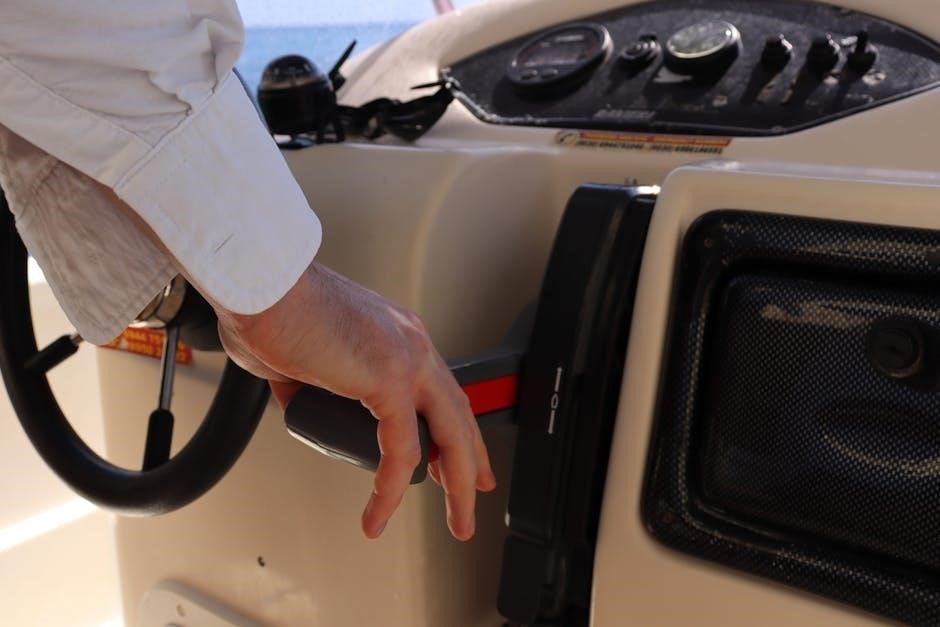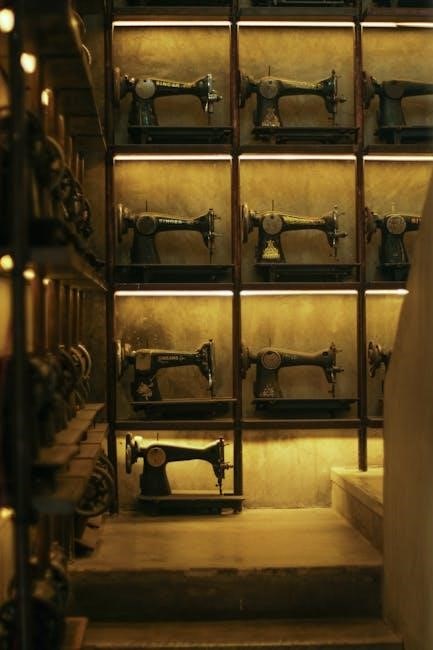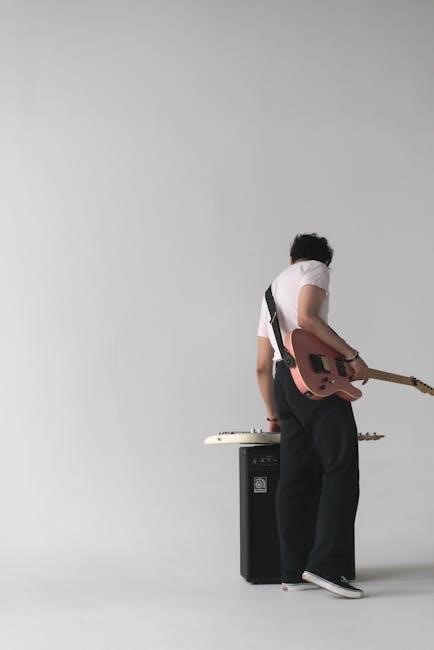Welcome to the Singer 237 Sewing Machine manual! This guide provides comprehensive instructions to help you master your sewing experience․ Designed for both beginners and experienced sewists, it offers detailed insights into machine setup, operation, and maintenance․ Explore its features, troubleshooting tips, and creative possibilities to enhance your sewing projects․
1․1 History and Development of the Singer 237 Sewing Machine
The Singer 237 sewing machine was introduced as part of Singer’s Heavy Duty series, designed to combine durability and versatility․ Built with an all-metal frame, it offers robust performance for sewing thick fabrics and heavy-duty projects․ Its development reflects Singer’s commitment to innovation, catering to both home sewists and small-scale commercial use․ The model is part of a lineage of reliable sewing machines that have earned Singer a reputation for quality and dependability․ The Singer 237 manual provides detailed guidance on its operation, maintenance, and troubleshooting, ensuring users can maximize its capabilities․ This machine has become a trusted tool for sewists worldwide, supporting creative and practical sewing needs․
1․2 Target Audience for the Singer 237 Sewing Machine
The Singer 237 sewing machine is designed for a diverse range of users, from beginners to experienced sewists․ Its user-friendly features make it accessible to those new to sewing, while its heavy-duty capabilities appeal to professionals and hobbyists tackling thicker fabrics․ Home sewists, crafters, and small business owners benefit from its reliability and versatility․ The machine’s robust construction and ease of use ensure it meets the needs of various skill levels․ Whether for personal projects or commercial tasks, the Singer 237 is a versatile tool that adapts to different sewing requirements, making it a popular choice across multiple user groups․
1․3 Quick Start Guide for Beginners
Getting started with the Singer 237 is straightforward! First, unbox and inspect the machine․ Familiarize yourself with the parts and accessories included․ Plug in the machine and ensure it’s placed on a stable surface․ Thread the machine by following the guides, ensuring proper tension․ Select the desired stitch and adjust the settings as needed․ Place your fabric under the presser foot and begin sewing at a steady pace․ Practice on scrap fabric to get comfortable with the controls․ Refer to the manual for detailed threading instructions and troubleshooting tips․ With these simple steps, you’ll be sewing like a pro in no time․ Keep the manual handy for quick reference and enjoy your creative journey with the Singer 237․

Key Features of the Singer 237 Sewing Machine
The Singer 237 is a heavy-duty sewing machine with an all-metal frame, offering durability and versatility․ It handles thick fabrics and long seams effortlessly, making it ideal for heavy-duty projects․ With multiple stitch options and smooth operation, it delivers professional results for sewists of all skill levels․ Its robust design and powerful performance ensure years of reliable service, making it a trusted companion for creative and practical sewing endeavors․
2․1 Design Overview and Build Quality
The Singer 237 sewing machine features a robust, all-metal frame that ensures durability and stability during operation․ Its compact design makes it suitable for various workspaces, while the sleek, DuraPresser finish enhances its appearance․ The machine’s solid build contributes to its heavy-duty capabilities, allowing it to handle thick fabrics effortlessly․ The overall design emphasizes functionality, with easy-to-reach controls and a clear workspace․ Weighing in at a substantial 20 pounds, the Singer 237 is built to last, offering a reliable sewing experience for both professionals and home users․ Its construction reflects Singer’s commitment to quality, making it a trusted tool for sewing enthusiasts․
2․2 Stitch Options and Customization
The Singer 237 sewing machine offers an impressive array of stitch options, including straight, zigzag, and decorative stitches, catering to diverse sewing needs․ With adjustable stitch length and width, users can customize settings to suit various fabrics and projects․ The machine also features a reverse stitch option for secure seams․ Additionally, the tension can be fine-tuned for optimal stitching on different materials․ This versatility allows for personalized control, making it ideal for both basic and intricate sewing tasks․ The Singer 237’s stitch customization options empower users to achieve professional-quality results with ease, ensuring every project meets their creative vision and practical requirements․
2․3 Heavy-Duty Capabilities and Performance
The Singer 237 sewing machine excels in heavy-duty applications, powered by a robust motor that effortlessly handles thick fabrics like denim and canvas․ Its metal frame ensures durability and stability, minimizing vibrations for consistent stitching․ With a high sewing speed, it efficiently manages large-scale projects, making it ideal for both heavy-duty tasks and lighter fabrics․ This versatility, combined with its powerful construction, allows users to tackle a wide range of sewing projects with confidence and precision, ensuring reliability and professional-quality results․

Parts and Accessories of the Singer 237
The Singer 237 comes with essential accessories like bobbins, needles, and a dust cover․ Optional attachments enhance functionality, while compatible Singer tools expand its versatility․
3․1 Standard Accessories Included with the Singer 237
The Singer 237 sewing machine comes with a variety of standard accessories to help you get started with your sewing projects․ These include multiple bobbins, a set of sharp, durable needles, and a convenient dust cover to protect your machine when not in use․ Additionally, you’ll find a selection of basic presser feet, such as the all-purpose foot for general sewing and the zipper foot for precise stitching․ These accessories are designed to support a wide range of sewing tasks and ensure you have everything you need to begin crafting immediately․ The inclusion of these essentials enhances the overall value and usability of the Singer 237․
3․2 Optional Accessories for Enhanced Functionality
To further enhance your sewing experience with the Singer 237, several optional accessories are available․ These include specialized presser feet, such as a walking foot for heavy fabrics or a quilting foot for larger projects, which improve stitch quality and control․ An extension table is another useful accessory, providing additional workspace for managing bulky fabrics․ Additional bobbins and needles can also be purchased, allowing for more thread color options and compatibility with various fabric types; These optional accessories enable you to explore advanced sewing techniques and expand the capabilities of your Singer 237 sewing machine, making it even more versatile for your creative projects․
3․3 Compatibility with Additional Sewing Tools and Attachments

The Singer 237 is designed to work seamlessly with a variety of additional sewing tools and attachments, expanding its functionality․ Compatible attachments include zipper feet, hemming feet, and edge joiners, which can be easily fitted to handle specialized tasks․ The machine also supports standard Singer sewing accessories, ensuring versatility for different projects․ This compatibility allows users to explore advanced sewing techniques and customize their workflow․ Whether you’re working on heavier fabrics or intricate designs, the Singer 237’s adaptability makes it a reliable choice for both beginners and experienced sewists, enabling you to achieve professional results with ease and precision;

Setup and Installation of the Singer 237
Setting up the Singer 237 involves unboxing, placing it on a stable surface, and assembling any additional parts․ Ensure all components are included and undamaged before use․
4․1 Unboxing and Initial Setup Process
Unboxing the Singer 237 sewing machine is an exciting first step․ Carefully remove the machine from its packaging and inspect for any damage․ Ensure all accessories, like the power cord, foot pedal, and standard presser feet, are included․ Place the machine on a stable, flat surface, such as a sewing table or countertop․ Before turning it on, familiarize yourself with the control panel andbobbin compartment․ Organize the included parts and accessories for easy access․ Finally, read the manual thoroughly to understand the machine’s features and operation․ This initial setup ensures a smooth and safe sewing experience for beginners and experienced users alike․
4․2 Step-by-Step Threading Guide
Threading the Singer 237 sewing machine is a straightforward process․ Begin by placing the spool of thread on the spool pin․ Gently pull the thread through the tension discs, ensuring it passes through the correct channel․ Next, guide the thread around the take-up lever and through the eye of the needle․ Use the handwheel to lower the needle slightly, then pull the thread to seat it properly․ For the bobbin, place the thread through the bobbin winder and wind it until full․ Cut the thread, then insert the bobbin into the bobbin case․ Ensure the thread is taut but not overly tight․ Finally, test the tension by pulling gently on the thread․
4․3 Oil and Lubrication Requirements
Regular lubrication is essential to maintain the Singer 237 sewing machine’s performance․ Use high-quality sewing machine oil, as specified in the manual․ Apply a few drops to the bobbin hook area and the tension discs․ Gently rotate the handwheel to distribute the oil evenly․ Ensure the machine is turned off before lubricating․ Avoid over-oiling, as it may attract dust and dirt․ For heavy-duty use, lubricate every 10 hours of operation․ Always refer to the manual for specific oil application points․ Proper lubrication ensures smooth operation, reduces friction, and extends the machine’s lifespan․ Regular maintenance prevents mechanical wear and keeps the Singer 237 running efficiently․

Basic Operations and Sewing Techniques

The Singer 237 sewing machine operates smoothly with basic techniques․ Start with proper fabric alignment, use the foot pedal for control, and guide fabric steadily․ Always maintain consistent tension for even stitches․ Practice straight-stitch sewing before exploring decorative options․ Regularly check thread tension to ensure professional results․ Keep fabric moving at a steady pace to avoid puckering or uneven stitching․ These fundamental techniques will help you master both simple and complex sewing projects efficiently․
5․1 Selecting the Right Stitch for Your Fabric
Selecting the appropriate stitch for your fabric is essential for optimal results․ The Singer 237 offers various stitch options, each suited for specific materials․ For lightweight fabrics like cotton or polyester, use the straight stitch․ Stretchy fabrics benefit from the zigzag stitch, while delicate materials like silk require a fine, short straight stitch․ Heavier fabrics, such as denim, can handle the heavy-duty straight stitch․ Always consult the stitch chart on your machine to match the fabric type with the correct stitch․ Testing on a scrap piece ensures the stitch choice and tension are suitable, preventing damage to your project․
5․2 Basic Sewing Techniques for Beginners
Mastering basic sewing techniques is crucial for beginners using the Singer 237․ Start by ensuring the machine is properly threaded and the correct needle is installed․ Practice sewing straight lines on scrap fabric to get familiar with the machine’s rhythm․ Use the handwheel to guide the fabric smoothly under the needle․ Backstitch at the beginning and end of seams for durability․ For even stitching, maintain consistent fabric tension and keep the fabric moving at a steady pace․ Practice sewing curves and corners by gently pivoting the fabric․ These foundational techniques will help build confidence and improve your sewing skills over time․
5․3 Adjusting Tension and Stitch Length
Adjusting tension and stitch length on the Singer 237 ensures optimal sewing results․ The tension dial controls the tightness of the stitches, while the stitch length dial determines the size of the stitches․ For lightweight fabrics, a shorter stitch length (2-3mm) is ideal, while heavier fabrics require longer stitches (4-5mm)․ To adjust tension, turn the dial until the thread flows smoothly without pulling too tight or loose․ Test stitches on scrap fabric to ensure evenness․ Proper adjustment prevents puckering, loose seams, or broken threads․ Always refer to the manual for specific settings for different fabrics and techniques․

Advanced Features of the Singer 237
The Singer 237 offers advanced features like automatic needle threader, LED light, and heavy-duty stitching․ These enhance precision and efficiency for complex sewing projects․
6․1 Using the Pattern Projector for Precision Sewing

The Singer 237 features a built-in pattern projector, designed to illuminate stitching patterns onto fabric for precise alignment․ This advanced tool enhances visibility, making intricate designs easier to sew․ To use it, simply select your desired stitch pattern and adjust the projection brightness․ The clear light ensures accurate placement, reducing errors and saving time․ Ideal for quilting, embroidery, or decorative stitching, the pattern projector allows for professional-looking results․ It’s a game-changer for sewists aiming for perfection in their projects․ Follow the manual’s guidance to optimize this feature and achieve flawless stitching every time․
6․2 Heavy-Duty Sewing Machine Options and Capabilities
The Singer 237 is engineered for heavy-duty sewing, offering robust capabilities for thick fabrics like denim, canvas, and leather․ Its powerful motor ensures smooth operation even with heavy materials, while the all-metal frame provides durability and stability․ The machine supports a wide range of stitch types, including heavy-duty options, and features an automatic needle threader for efficiency․ With a maximum stitch speed of 1,100 stitches per minute, it’s ideal for large-scale projects․ The heavy-duty capabilities make it suitable for professionals and home sewists tackling demanding tasks․ This feature-rich machine balances power with precision, ensuring reliable performance for both heavy-duty and delicate sewing needs․

Maintenance and Troubleshooting
Regular cleaning and oiling are essential for the Singer 237’s longevity․ Lubricate moving parts and check for worn components․ For issues like thread breakage or noise, consult the troubleshooting guide for solutions․
7․1 Regular Maintenance Tips for Longevity
Regular maintenance is crucial to ensure the Singer 237 sewing machine operates smoothly and lasts for years․ Start by cleaning the machine thoroughly, removing lint and debris from the bobbin area, tension discs, and feed dogs․ Use a soft brush or compressed air for this purpose․ Next, lubricate the machine with Singer-recommended oil, focusing on moving parts like the shuttle hook and gear areas․ Replace the needle regularly to prevent breakage and fabric damage․ Check belts and hoses for signs of wear and tear․ Finally, store the machine in a dry, cool place, away from direct sunlight, to protect its finish and internal components․
7․2 Common Issues and Troubleshooting Solutions
The Singer 237 sewing machine, like any mechanical device, may encounter issues․ One common problem is thread bunching or uneven stitching, often caused by incorrect threading or tension․ To resolve this, rethread the machine and adjust the tension discs․ Another issue is a broken or bent needle, which can damage fabric․ Always use the correct needle type and size for your fabric․ If the machine is noisy or vibrates excessively, check for loose parts or debris inside․ Clean the interior and ensure all components are securely tightened․ For persistent problems, consult the Singer 237 manual or contact authorized service providers for professional assistance․
8․1 Final Thoughts on the Singer 237 Sewing Machine
The Singer 237 sewing machine is a versatile and user-friendly appliance designed for both beginners and experienced sewists․ Its robust construction and wide range of stitch options make it ideal for various sewing projects․ With proper care and regular maintenance, the Singer 237 can deliver years of reliable service․ Whether you’re crafting garments, repairing fabrics, or creating decorative items, this machine offers the precision and durability needed to achieve professional results․ By following the Singer 237 manual, users can unlock its full potential and enjoy a seamless sewing experience․
The Singer 237 sewing machine stands out as a reliable and versatile tool for sewists of all skill levels․ Its durable design and wide range of stitch options ensure it can handle various fabrics and projects effortlessly․ Whether you’re a beginner or an experienced sewer, this machine offers simplicity and precision․ The included accessories and clear manual make it easy to get started, while its robust construction promises long-term performance․ With proper maintenance, the Singer 237 can become a trusted companion for years of creative sewing․ Its blend of functionality and affordability makes it an excellent choice for anyone looking to enhance their sewing capabilities․
8․2 Resources for Further Learning and Support
For further learning and support, users of the Singer 237 sewing machine can explore various resources․ The official Singer website offers detailed manuals, instructional videos, and FAQs․ Additionally, YouTube channels and sewing blogs provide step-by-step tutorials and tips tailored to the Singer 237․ Sewing communities and forums are excellent for connecting with experienced users and troubleshooting common issues․ Local sewing classes or workshops can also offer hands-on guidance․ Singer’s customer support team is available for direct assistance with machine-specific queries․ These resources ensure users can maximize their sewing experience and overcome any challenges they may encounter while using the Singer 237․
